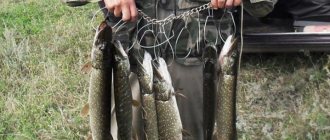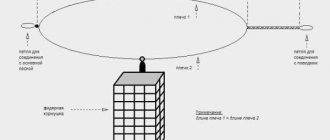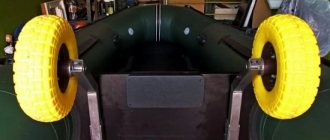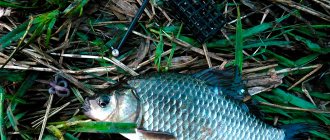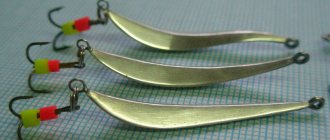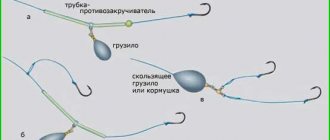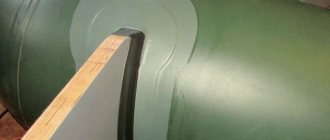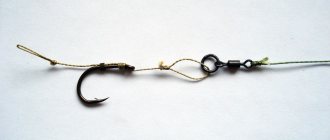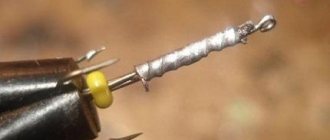Advantages of a knotless fastener
- The “Not a knot” clasp allows you to tie baits to a braided fishing line and no longer worry about the braided cord fraying and breaking over time on a large fish or hook.
- Tying baits/changing one for another has become faster than ever. Removing one lure and tying another takes about 10 seconds, and the tying procedure is very simple.
- No knots - no weak points. The line breaks anywhere, but not in the place where the bait is tied to the line.
Which is better: a node or a nodeless connection?
The leash can be attached to the fishing line in two ways: with a knot or using a knotless fastener. Let's take a closer look at the features of these fasteners.
Node advantages:
- suitable for both fishing line and braid;
- when the line breaks, it breaks at the knot, and not in the middle;
- there is no extra element.
Flaws:
- low strength;
- inconvenience of connection (tying knots).
Advantages of a knotless clasp:
- strength;
- minimum time and effort for tying the equipment to the fishing line.
Flaws:
- used mainly for braiding;
- an extra element that weighs down the tackle;
- If the cord breaks, the break most likely will not be at the connection, but in the middle.
Thus, both types of connection have both pros and cons. For each specific case, a different method of fastening is suitable. So, for fishing using a cord, it is more advisable to knit the tackle using a fastener, but when fishing, for example, with a microjig or ultralight, unnecessary elements are not needed, so a knot is suitable.
How to tie a knotless clasp to fishing line
How to use a knotless fastener:
- To begin, place the eye of the bait behind the rounded part of the knotless fastener.
- Loop the end of the main line over the hook of the fastener to create a double line.
- The double line must be wrapped around the fastener at least 4 times.
- And the final stage: put the fishing line behind the latch.
- The bait is tied, all subsequent baits will be tied even faster.
Multiplier reels for spinning rods - a guide to the selection and proper use of multipliers in spinning fishing.
Rating of the 5 best budget and premium spinning reels on the next page.Poppers for pike and techniques for catching pike with surface lures.
Where is a knotless fastener used?
Area of application - mainly spinning fishing for predators (for example, pike, catfish, living in freshwater and flatheads, scorpion fish, sea dragon, faridae and other owners of the Mediterranean Sea).
Places of application - unsnaggled and algae-free areas of a reservoir with a clean bottom (for example, such areas are chosen when catching pike by twitching with minnow wobblers). Under such ideal fishing conditions, hooks are excluded, and the braided line used can be taken with the smallest diameter, which will ensure the flight range of the bait.
This type of knotless connection is especially popular among sports fishermen, for whom the speed of changing equipment is sometimes a fundamental factor in winning.
In what variants of spinning fishing does this installation occur:
How to make a knotless clasp with your own hands
You can make a knotless fastener with your own hands; moreover, it is even advisable to do this if you are a fan of ultralight fishing. It is not so often that you can find fasteners with thin wire on sale.
Materials and tools that will be required:
- guitar string of the required diameter (0.13 is just right)
- needle nose pliers for bending strings
The manufacturing process is described in detail in the following video:
The knotless fastener is very helpful with constant changes of bait, and it also does not impair the performance of wobblers, which can be negatively affected by the use of swivels with a fastener.
primanki.com
Knotless clasp for braiding: how to make and tie
Hello friends. Knotless fasteners, or simply “knotless” clasps, have recently become increasingly common in fishing equipment. This is understandable. The connection is stronger, even than on Palamar. Knits up in seconds. There are, however, some disadvantages. However, while using the knotless connection with braid, I didn’t even think about them. The tackle is slightly heavier (a debatable issue) and the braided cord, if properly applied to the hook, breaks not at the connection point, as when using knots, but in the gap between the spinning tulip and the bait. What to do? There is no need to take it to extremes.
I made my first knotless fasteners for braided fabric myself. I took pieces of wire about 0.3 - 0.4 mm thick. At best it was nichrome, and usually whatever came to hand. There is enough material if you look for it. And using bench tools he bent it. Compared to store-bought ones, it turned out a little clumsily, but the knotless one fulfilled its function.
But in order to save money, you can make a knotless fastener yourself. If you intend to constantly tinker, then you can make a machine. We make a template on a wooden block or a cut from a board. For convenience, we apply a ready-made knotless piece and hammer in three window nails in the right places (these are used to nail glazing beads). Of course, we remove the caps and remove the burrs.
Then, using wire, you can even use a paper clip, we bend the structure. We remove the excess and, if necessary, process the sharp edges with a needle file.
I agree that the task is painfully painstaking and time-consuming. But if it is necessary, then it is necessary. Or to the store.
A knotless connection made in this way (or bought in a store) can be used to tie braid to a wobbler if you are fishing with ultra-light tackle, or through a leash. I use my own fluorocarbon leaders. On one side there is a knotless strap, on the other there is a carabiner.
When fishing with a rotating spoon, I remove the knotless connection and install a swivel; with a spinner, I leave the fastener in place. The fact is that a knotless knot promotes twisting of the braid, since a spinner, unlike a wobbler, has the habit of rotating around its axis.
How to tie a knotless clasp
First, let me note that there are some nuances. If you are fastening a knotless fastener with braided braid, it is advisable to wet the cord. This makes the connection stronger. Maybe I forgot something from the physics course, but when wet, a braided cord suffers less from the effects of friction. But this is until the moment the bait, along with the knotless hook, is in the water.
So.
The technique of connecting a knotless cord and a braided cord is simple.
- Fold the end of the braid in half.
- Throw the resulting loop onto the hook of the fastener.
- Next, we wind the double end of the braided cord towards the bend of the fastener.
- We lay it evenly, ring to ring, all over the knotless body.
- At the very end, we place the remainder under the latch and, if necessary, remove the excess tip.
That's it, the braid and knotless clasp are ready to go. And don’t worry about the safety of the bait. Believe me, I throw expensive wobblers as hard as I can, twitch, pull pikes out of bushes and snags - there were no problems. I tell all my friends and acquaintances that a knotless fastener for braided fabric is what you need.
How to tie a knotless clasp?
The knotless braided clasp is very easy to tie. You just need to have basic knowledge about tying knots and follow the instructions. This is done as follows
:
- First, select the required size fastener. The size of the fastener is influenced by the thickness of the braided line, as well as the size of the bait. Choose a fastener that will exceed the diameter of the braid by a few tenths of a millimeter.
- Now you need to insert the eye of the equipment inside the eye of the fastener.
- Now you need to put the fishing line on the hook of the fastener, which protrudes, so that a double thread is formed.
- Now the fishing line is wound onto the connector 3 to 6 times.
- All that remains is to insert the braid into the fastener - the second eye of the fastener - and tighten it.
- Remove excess line.
The braid does not stretch, so knitting a fastener for such material will be optimal. You can tie a fishing line, but you won’t be able to achieve the same effect as with a braided thread.
Knotless clasp on a long leg - 50 pcs.
Price without discount – $1.11 – $1.91 Discount price – $0.088 – $0.15 Discount – often there is an 8% discount Rating – 4.9 Sold – over 892 Reviews – over 668 (609 – 5 stars)
Characteristics goods.
Size range. For your choice of 5 sizes of knotless fasteners, see the photo:
About the seller. The seller of this product has been on the Chinese market for 4 years. Has a large number of sales and a lot of positive feedback. The product he offers is the most optimal based on the store’s rating!
About the price. The price of the first fastener size L - 16 mm without a discount is $0.030 (~1.9 rubles), and if there is a discount of 8%, then you can purchase this fastener even cheaper. In addition, taking advantage of cashback will make your purchase even more profitable. Delivery of goods is free, which also saves you money.
Buy a product on the aliexpress website
How to make it yourself
The possibility of self-production is an undeniable advantage of such fasteners. In order for a knotless fastener for a do-it-yourself braid to turn out to be of high quality, you need to stock up on the following materials
:
- A piece of wire with a diameter of 0.6 to 0.8 millimeters.
- Round nose pliers.
- With pliers.
- With wire cutters.
To make it follow these steps
:
- Before you start manipulating the wire, make sure there are no jagged ends at its end. If the tip catches, it must be removed using pliers.
- Now you need to bend the tip of the wire 180 degrees; for this it is best to use pliers.
- Now you need to bend this bend in the other direction using the same tool.
- Then you need to bend the edge of the wire with pliers so that a hook is formed.
- Use pliers to cut off the required length of wire.
- The other end of the fastener must be bent 90 degrees.
- Press the wire with pliers to form a loop.
- Ready, all that remains is to attach the accessory to the tackle and you can use it.
Buzz clasp – 50 pcs.
Price without discount – $2.11 – $2.56 Discounted price – $1.16 – $1.41 Discount – often up to 45% off Rating – 4.9 Sold – over 1100 Reviews – over 996 (955 – 5 stars )
Product Detail.
Size range. Look below in the photo:
About the seller. In this lot, the price is justified by the reliability of the seller and the quality of the goods, which is confirmed by the number of sales of knotless items.
About the price. The price of one clasp size L - 16 mm without a discount is $0.056 (~3.5 rubles), and if there is a 45% discount, then you can purchase this clasp at an even more favorable price of $0.035, and if you use cashback, then the purchase will become even more profitable. Delivery of this purchase is paid, but if the cost of the product is not important to you, but its quality is important, then this product is what you need.
Buy a product on the aliexpress website
Advantages of a knotless fastener
- Using such a fastener allows you to attach baits of any size to the braid and not worry about the thread wearing out or breaking at the connection point.
- The use of a fastener significantly increases the speed of bait replacement. You can change the bait literally in a matter of seconds.
- Easy to make yourself.
- Weak points in the equipment are not created, since the connection does not involve nodes. The braid can break in any other place, but not in the place where the bait is fixed.
- The possibility of loosening the thread while fishing is completely eliminated.
Fishermen note one drawback, although some even say that this is an advantage. It doesn't matter how it's considered, but it's worth mentioning.
Increased strength of the connection can lead to breakage of the braid in any other place.
getfish.net
What kind of connection is this?
A knotless fastener is a shockingly simple, but at the same time ingenious device that allows you to tie the bait to the main line without a knot, thus maintaining 100% strength. A knotless knot is a small piece of wire with a loop on one end and a loop with a hook on the other.
The fishing line wraps around this wire in a special way and is held in place by friction. I note that knotless ones can only be used with braided fishing lines. Smooth, slippery monofilament lines cannot be secured to such a device, as they will come undone.
In addition to high connection strength, a knotless clasp has another advantage over a conventional clasp - the time it takes to tie. In order to wrap a fishing line around a wire with eyes and a hook, it takes at most 10 seconds, while complex fishing knots sometimes take much longer to knit.
In this way, the angler saves precious minutes of fishing. Knotless fasteners are also compact, which makes them very attractive for lovers of light and ultra-light spinning rods.
Knotless fishing rods have become a real godsend for sports fishermen. For those who compete, it is very important to have reliable, delicate tackle and save precious seconds, which can sometimes decide the outcome of the fight.
Amateur fishermen, for the most part, still use regular carabiners, or tie the fishing line directly to the winding or fastening ring on the bait. However, I believe that we need to gradually move away from outdated methods and use all modern inventions. Especially if they are available.
How to knit a knotless pattern?
Tying a knotless clasp to the end of a cord is very simple. First, let's take a closer look at the diagram.
- First you need to insert the ring of the bait or leash into the eye with the hook. This is done very quickly and simply.
- Next, you need to fold the end of the fishing line in half and throw it on the hook.
- Now the double fishing line needs to be wrapped around the wire. The more turns there are, the more reliable the connection you will get. For example, I do 6-8 turns. But some limit themselves to 4, believing that this is quite enough.
- After the cord is wound onto the wire, you need to insert it into the locking ring.
Well, that's all! We got a very reliable connection without any nodes. At first glance, it may seem that the connection is complex, and it will not be possible to make it in 10 seconds. It's a delusion! You just need to do the procedure a few times at home, and on the pond you will be attaching the fastener to the fishing line in a matter of seconds!
I also want to pay attention to this question: buy or make? Knotless fasteners, even very high quality ones, can be bought at a fishing store for literally pennies! But, unfortunately, small things of this kind are sometimes simply impossible to find in small fishing stores located in small towns. Of course, you can always order the necessary item via the Internet, or make the required part yourself.
A knotless fastener is made of thin, springy wire. Using pliers, you need to make all the bends, and you will get a good fastener. However, you can only make fasteners for large baits yourself. If you fish with ultralight, then it’s better to just place an order in the online store.
A little about the disadvantages
A knotless clasp may seem like just the perfect device, because it:
- maintains the strength of the fishing line;
- quickly installed;
- much more compact than a regular carabiner.
And what disadvantages might this device have? Oddly enough, the main advantage of knotless (the ability to maintain the strength of the connection), in some situations, is also a disadvantage.
Often when fishing there are situations when a braided cord gets tangled so much that you have to remove the section with the beard and tie the ends of the two sections with a knot. There are many compact knots for connecting the two ends of the cord, which retain up to 95% of the strength. But a knotless clasp retains 99-100% strength...
If during a full release you get a dead hook, the cord will break not near the bait, but at the connection point. Thus, you will tear off a large piece of expensive braiding, and also make it difficult to further catch the point, because the hooks of the baits will cling to the torn cord. Therefore, if you have knots on the fishing line, it is better not to use knotless ones.
By the way, the fishing line can break in the middle even if you rewind the cord so that the fresh section is at the top and the worn section is at the bottom. In this case, the braid may tear at the transition point between the worn and new section.
A knotless carabiner is an excellent alternative to a conventional carabiner. But if you want to tie and test it, first make sure there are no weak points in the cord, otherwise serious damage may occur. No tail, no scales!
tvoyarybalka.ru
DIY knotless connection
Last summer I discovered a knotless fastener (not a knot). The thing is quite common in the West, and in our country more and more fishermen are starting to use them, however, at the moment, a good half of spinning anglers have no idea about the existence of such a device, so I’ll try to correct this situation a little.
The first question is – buy or make? “Aknotes” are found on sale, but rarely, at least in serious stores. The quality of cheap ones, to be honest, leaves much to be desired; good roads are not common.
Personally, I prefer to make them myself, especially since it doesn’t take much labor, time and materials, and it’s not difficult to compete with the “Firm” in quality.
Well, you can make the fastener exactly the way you need it, choose the optimal dimensions and characteristics. The material for production is stainless wire. You can take wire that is sold in fishing stores, or use wire for orthodontic devices. It can be obtained, for example, in medical equipment stores.
I usually use wire with a diameter of 0.5 mm; fasteners made from it are optimal for braiding with a breaking load of 5-7 kg. and fishing line with a diameter of up to 0.3 mm (the sample length in the photo is 15 mm). For coarse cords, you can make larger fasteners.
For ultra-light class gear, the use of knotless installation is not always justified, but if necessary, with a certain skill, you can make micro fasteners from wire with a diameter of 0.4 mm. and even thinner.
There are not many tools: “semi-round pliers”, round nose pliers and wire cutters (side cutters). The wire cutters, or the tool with which you are going to bite off the wire, must be sharp so that the wire is flattened as little as possible and no burrs remain.
A complete set of tools is naturally not necessary, but it will greatly simplify your task, and the result will please the eye.
- First you need to make sure that the tip of the wire does not have burrs, otherwise it will be bitten off with wire cutters.
- We take the tip with round nose pliers (to obtain miniature fasteners, you need to use their thinnest ends) and bend it 180 degrees (photo 1).
The clasp is ready! Attention!
That's all, you see, tying in this way is much easier and faster than with a regular knot!
Knotless installation has both a number of advantages and disadvantages. The main, and perhaps the only drawback, is that the knot turns out to be too strong, the loss of strength is only a few percent. Some braided cords, especially after long-term use, have “weak spots” and if there is a dead hook, the braid can break in the most unexpected place. Although such troubles still occur quite rarely, usually the cord breaks at the fastener, or at the very beginning, where it receives “microtraumas” from the “tulip” of the spinning rod during casting.
There are a lot of advantages. First of all, this is again strength. Even the neatest knot eats up a good part of the strength of the fishing line or braid. Secondly, the time required for tying is reduced to a matter of seconds, which saves precious minutes and nerves. Thirdly, convenience and simplicity allow you to tie the clasp with frozen fingers, in poor lighting, in strong winds and even while wearing gloves. Is it worth reminding us that we only have the month of May once a year?
As they say, neither tail nor scales, gentlemen fishermen!
Positive and negative sides
Knotless has many positive aspects:
- Easy to connect to the main line and other fishing products with eyes or rings, allowing you to easily and quickly change them.
- Light weight that does not interfere with the play of the bait.
- Reliable knotless connection without loss of breaking load.
- Simplicity of design , allowing for independent production of “Not a knot”.
There are also negative sides:
- Volumetric connection , which does not allow the lines to be tied together.
- Possibility of using knotless connection only with braided cords .
The order of connection with the main braided line
“Not a knot” come in different sizes: S, M, L, XL. The thicker the line, the larger the knotless size.
Before tying the knotless cord to the main cord, you need to put a spinner or other necessary equipment element on the S-shaped loop of the knotless cord.
- Fold a small piece of braid in half.
- We place the cord loop on the “c”-shaped section of the knotless loop.
- We begin to twist the double cord around the knotless rod in the same direction where the lowered end of the oval loop of the knotless fastening is facing.
- We make from 3 to 6 turns depending on the diameter of the cord.
- We insert a double cord into an oval loop.
- Trim the protruding end of the cord, leaving ½ cm.
There are mandatory rules for reliably connecting the fishing line with the “Not a knot”:
- Be sure to wind the line in the same direction where the lowered end of the oval fastener is facing.
- Make at least three turns for thick braided fishing line, at least 6 turns for thin line.
- Do not twist the double cord when turning around the knotless rod.
- Wrap the braided line around the rod, turn to turn.
Characteristics of a nodeless connection
The design of the knotless design is determined based on the material used to make the accessory (metal wire) and is characterized by:
Different knotless models differ not only in shape, but also in breaking load. A fastener is considered good if, under critical loads, it is deformed (stretched, twisted), but does not unfasten.
For example, the area of application of the fastener, depending on its design features, is ultralight when using mini wobblers and poppers. With this type of spinning fishing, light-weight fasteners are used, made of thin wire material and small in size, since they have minimal resistance in the water and do not affect the play of baits, for example, wobblers.
2.1 Knotless connection test and size
Like all equipment elements, knotless ones also have their own weight and dimensional characteristics, which are indicated by the manufacturer on the packaging, for example, test (strength) 15 kg, 35 kg and size S, XL, etc.
The knotless fastener test is a characteristic that indicates the strength of an element when exposed to a specific weight. If the specified figure is exceeded, the knotless part may become deformed or break.
Advice - select knotless ones with a test slightly less than the strength of the fishing line in order to preserve the fishing line and allow the connector to deform under excessive loads rather than the fishing line.
All the most interesting things about monofilament fishing line - read here
Attaching monofilament to knotless
The generally accepted opinion is that the connection between a knotless line and a monofilament line is unreliable. This statement is only partially true. A thin monofilament line up to 0.12 mm in diameter connects quite reliably to the “Not a knot”. You just need to make at least 8 turns in the right direction, turn to turn around the rod. A larger diameter line from 0.12 to 0.2 mm can indeed slip under heavy loads, but there is a way to eliminate this disadvantage, although this makes the tying process somewhat more complicated.
The method is as follows:
- Having put the fishing line on the “c” shaped section of the loop, we lower it along the “s” shaped loop lower to the rod and begin to rotate the knotless part in the direction where the lowered end of the oval loop points. The double line twists among itself.
- Having obtained a uniform, tight twist, we again transfer the monofilament loop to the “c” shaped section S - the loops of the knotless connection.
- Next, we wind according to all the rules, inserting a double fishing line into an oval loop. Unravel the excess end of the double fishing line. We cut off the protruding end, leaving ½ cm.
Disadvantages of knotless
With the use of knotless fishing equipment, an important problem is solved - connecting equipment elements without the use of fishing knots.
What problems might arise? Unpredictability of braided line breakage (for example, with a diameter of 0.2 mm). After all, when a knot is tied, the fisherman already assumes and allows for a break in the installation in this very place, but when using a knotless element, it is impossible to determine the area of the break, since it is impossible to know in advance where the manufacturing defect lies in a particular accessory. This is the main disadvantage of using a knotless fastener. Also, as a disadvantage, we can highlight the weight factor of the fishing rod equipment.
Self-production
Depending on the desired size of the knotless connection, ferrous wires of various diameters are used.
- for size S, 0.13 mm guitar string is suitable ;
- for M – the diameter of the ferrous wire can be from 0.14 to 0.24 mm ;
- for L – ferrous wire 0.24 – 0.42 mm ;
- for XL - ferrous wire can have a diameter of 0.46 - 0.8 mm .
There are 2 ways to make knotless ones.
Method I Instrumental.
You will need:
- round nose pliers;
- pliers;
- a nail or iron rod with the cross-section necessary to form loops of the required diameter;
- side cutters.
Procedure:
- We cut the wire of the required length for a knotless connection of the required size. For XL size, the piece can be approximately 5 cm long.
- We bend one end of the wire with round nose pliers in one direction, forming a “C”-shaped section of the loop.
- Insert the round nose pliers into the resulting hook (letter “C”) again and bend it in the opposite direction until the letter “C” touches the knotless rod. This creates an “S”-shaped loop. If the "C" hook does not reach the rod, it must be bent with pliers.
- At the other end of the wire, make an oval loop with pliers, lowering the end of the oval loop in any direction.
- We cut off the excess end of the loop with side cutters, leaving ½ - 1 mm of wire below the knotless rod.
The knotless pattern is ready.
Pliers will be needed if the hinges do not lie in the same plane and need to be slightly aligned.
A nail or rod will be needed if you cannot screw the loops with pliers without forming burrs and irregularities that can disrupt the integrity of the cord structure.
II method. Machine tool.
- We make a machine for winding wire for L size knotless.
- we pierce a thin wooden board through with a nail No. 1 with a diameter of 2 mm;
- 3 cm from the first nail, we pierce the board through with another nail (nail No. 2) of the same diameter;
- use side cutters to bite off the tip of both nails;
- draw a line on the board with a thick pencil from the center of the first nail to the center of the second;
- We mark the place where the third nail was pierced. It should touch the drawn line on the right and be 2 mm below the first nail;
- punch through the third nail, bite off the tip.
The machine is ready.
- We wind the wire, starting with nail No. 3.
- Next we go around nail No. 1.
- We stretch the wire to nail No. 2, make an oval loop, lower the end of the wire below the rod, as shown in the previous photo.
- We cut off the excess ends of the wire with side cutters.
The knotless pattern is ready.
Mounting method
In practice, a knotless connection is more convenient than tying knots due to its simplicity. The key to a reliable connection in this case is the correct choice of device size. The knotless fastener for braided line with a diameter of 0.1 mm should be significantly smaller than for 0.25 mm monofilament. Further machinations are extremely simple:
- We place the loop of the leash or bait in the large eye of the clasp.
- Fold the end of the fishing line in half at a distance of 3-4 centimeters from the edge.
- We put the resulting loop on the fastener antenna.
- We wrap the fishing line around the body of the fastener 5-6 times.
- Snap the loop into the opposite eye. The connection is ready.
Experienced fishermen advise leaving the free end of the fishing line at least 1 centimeter to prevent it from slipping into the loop when the load is loosened and re-tensioned. To achieve the most durable connection, it is also recommended to pre-wet the fishing line or braid, which will allow it to tighten more tightly on the fastener.

